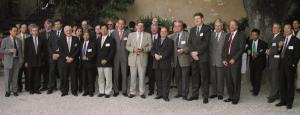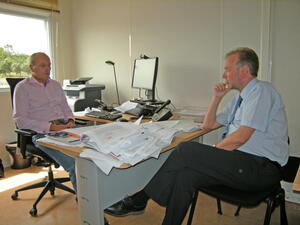2001-2007: The Making of ITER
Take a bit from the United Nations, a speck from the European Space Agency (ESA), some inspiration from the European Commission and the JET Joint Undertaking, a couple of good ideas from CERN and the International Space Station (ISS)—shake, adapt, streamline and you'll have the tailor-made international organization you need to build a project such as ITER.
"Between 1992 and 2001," remembers Harry Tuinder, now the Legal Advisor to the ITER Director-General, "a certain amount of preparatory work was accomplished within the framework of the ITER Engineering Design Activities (EDA). In November 2001, after Canada had offered a site, the formal ITER negotiations commenced and we began actively looking into possible models."
Discussions to prepare consensus and iron out the difficulties between the Negotiators were entrusted to a 40-person Negotiators Standing Sub-Group (NSSG). NSSG first met in Tokyo in December 2001, and was to convene eleven times between that date and 2007 to prepare Negotiators Meetings.
"We were embarking on a 35-year-long project. The Parties had committed very substantial investments and our first requirement was stability: we could not be dependant on a possible change of policy by one or another of the ITER Parties. So we quickly came to the conclusion that we needed a full-blown international organization based on an international agreement."
The procedure to create such an organization was "long and difficult" and further complicated, after the withdrawal of Canada in December 2003, by the absence of a decision concerning the siting of ITER until 2005.
ITER is unique in its nature, scope and objectives; the original Parties sometimes held different views on what kind of internal and governing bodies needed to be set up. They diverged on dispute settlement, project resource management, staff regulations, intellectual property, liability, voting rights... and even on how much vacation the staff would be entitled to.
"We tried to have the best of many worlds, but we also had to be inventive," says Akko Maas, ITER Senior Officer for External Coordination, who, as part of the European team that supported the European Site Studies, witnessed most of the five-year-long process.
The issue of the relations with France as the Host State was a particular headache for the Negotiators. "As an international organization," says Akko, "our premises are international. But we're not completely extra-territorial, like an embassy. We will be operating a nuclear installation and that means we had to work out a special provision in the ITER Agreement in order to observe national regulations regarding public health, safety, licensing and environmental protection."
Creating the ITER Organization, which was formally established on 24 October 2007, was "a big balancing act," says Harry Tuinder. A unique blend of "flexibility" and "commitment"; it is now, in some of its provisions, "a model for other large international science collaborations."



